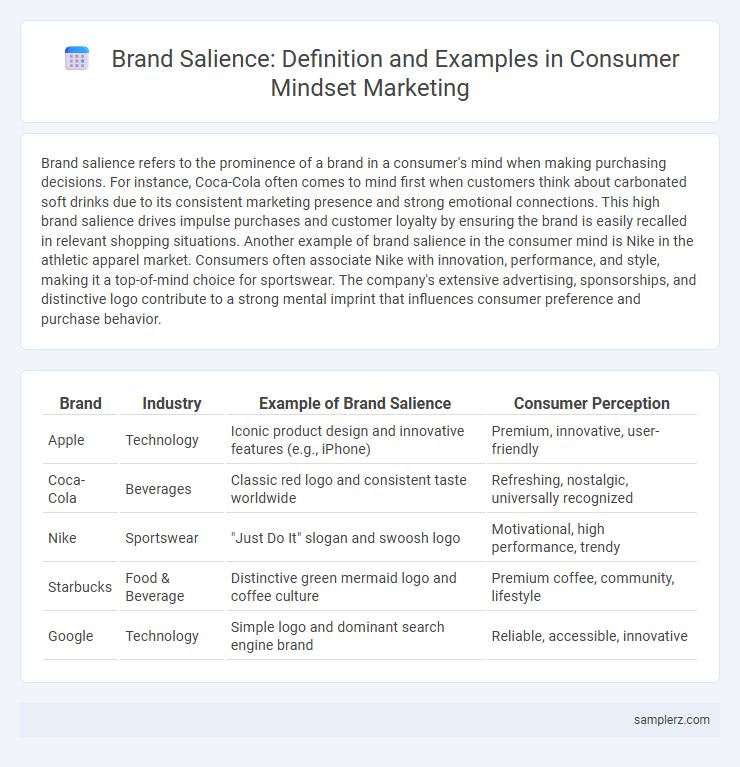Brand salience refers to the prominence of a brand in a consumer's mind when making purchasing decisions. For instance, Coca-Cola often comes to mind first when customers think about carbonated soft drinks due to its consistent marketing presence and strong emotional connections. This high brand salience drives impulse purchases and customer loyalty by ensuring the brand is easily recalled in relevant shopping situations. Another example of brand salience in the consumer mind is Nike in the athletic apparel market. Consumers often associate Nike with innovation, performance, and style, making it a top-of-mind choice for sportswear. The company's extensive advertising, sponsorships, and distinctive logo contribute to a strong mental imprint that influences consumer preference and purchase behavior.
Table of Comparison
| Brand | Industry | Example of Brand Salience | Consumer Perception |
|---|---|---|---|
| Apple | Technology | Iconic product design and innovative features (e.g., iPhone) | Premium, innovative, user-friendly |
| Coca-Cola | Beverages | Classic red logo and consistent taste worldwide | Refreshing, nostalgic, universally recognized |
| Nike | Sportswear | "Just Do It" slogan and swoosh logo | Motivational, high performance, trendy |
| Starbucks | Food & Beverage | Distinctive green mermaid logo and coffee culture | Premium coffee, community, lifestyle |
| Technology | Simple logo and dominant search engine brand | Reliable, accessible, innovative |
Understanding Brand Salience: Definition and Importance
Brand salience refers to how easily and often a brand is noticed or thought about by consumers in purchasing situations, influencing decision-making and preference. High brand salience ensures that a brand is top-of-mind, increasing the likelihood of consumer choice amidst competitive alternatives. Metrics such as brand recall, recognition, and mental availability are crucial indicators for marketers to evaluate brand salience and optimize marketing strategies accordingly.
How Brand Salience Influences Consumer Decisions
Brand salience significantly impacts consumer decisions by ensuring the brand is the first to come to mind during purchase consideration, increasing the likelihood of selection. High brand salience, as seen with companies like Coca-Cola or Apple, anchors consumer perception through memorable logos, consistent messaging, and widespread visibility. This top-of-mind awareness drives consumer trust, reduces search costs, and fosters habitual buying behaviors.
Top Real-World Examples of High Brand Salience
Nike consistently ranks high in brand salience, with its iconic swoosh logo and "Just Do It" slogan immediately recognized by consumers worldwide. Apple's brand salience is driven by its innovative product design and strong ecosystem, making its devices top-of-mind when customers think of technology. Coca-Cola achieves brand salience through its timeless red packaging and global advertising campaigns, establishing an emotional connection that keeps it prominent in consumers' minds.
Strategies Brands Use to Achieve Salience
Brands achieve salience in the consumer mind by consistently utilizing distinctive visual elements such as logos, colors, and packaging that enhance recognition and recall. Strategic repetition of key messages across multiple channels, including social media, television, and in-store promotions, reinforces brand presence and top-of-mind awareness. Leveraging emotional storytelling and aligning with consumer values also deepens brand salience by creating memorable and meaningful connections.
The Role of Brand Salience in Competitive Markets
Coca-Cola exemplifies brand salience by consistently appearing top-of-mind in consumers' beverage choices through iconic packaging and memorable advertising. High brand salience ensures Coca-Cola stands out amid numerous competitors in the soft drink market, driving repeat purchases and customer loyalty. This prominence enhances competitive advantage by reducing consumer decision fatigue and increasing the likelihood of automatic brand retrieval during purchase occasions.
Measuring Brand Salience: Key Metrics and Tools
Measuring brand salience involves tracking key metrics such as brand recall, recognition, and top-of-mind awareness through surveys and consumer research tools like aided and unaided recall tests. Digital analytics platforms assess online engagement, search volume, and social media mentions to provide real-time insights into brand prominence. These metrics help marketers evaluate how easily consumers identify a brand in various purchase situations, guiding strategic branding decisions.
Emotional Connections and Brand Recall
Strong emotional connections between consumers and brands significantly enhance brand salience by increasing recall during purchase decisions. Brands like Coca-Cola use consistent messaging and nostalgic imagery to evoke positive feelings, embedding themselves deeply in consumers' memories. This emotional resonance ensures the brand is top-of-mind, driving customer loyalty and repeat purchases.
Case Study: Iconic Brands with Unmatched Salience
Apple consistently dominates brand salience by embedding its identity deeply within consumer lifestyles through sleek design and innovative technology that resonate globally. Nike achieves unmatched salience by associating its brand with motivation and performance, reinforced by powerful endorsements and memorable campaigns like "Just Do It." Coca-Cola maintains top-of-mind awareness worldwide by creating emotional connections through universal themes of happiness and sharing, supported by consistent visual cues and nostalgic advertising.
Brand Salience vs. Brand Awareness: Key Differences
Brand salience measures how easily a consumer recalls or recognizes a brand under various conditions, reflecting its prominence in the consumer's mind, whereas brand awareness simply indicates whether a consumer knows the brand exists. For example, Coca-Cola demonstrates high brand salience as consumers can instantly associate it with taste, refreshment, and emotional satisfaction in diverse situations. This distinction highlights the importance of developing brand salience to influence purchasing decisions beyond basic brand recognition.
Building Long-Term Brand Salience in Consumer Minds
Building long-term brand salience requires consistent messaging and emotional engagement that embed the brand deeply into consumer memory. Brands like Coca-Cola achieve this by maintaining iconic symbols, such as their logo and advertising jingles, which trigger immediate recognition and positive associations. Leveraging multi-sensory marketing and memorable touchpoints strengthens consumer recall, ensuring the brand remains top-of-mind over time.

example of brand salience in consumer mind Infographic
 samplerz.com
samplerz.com